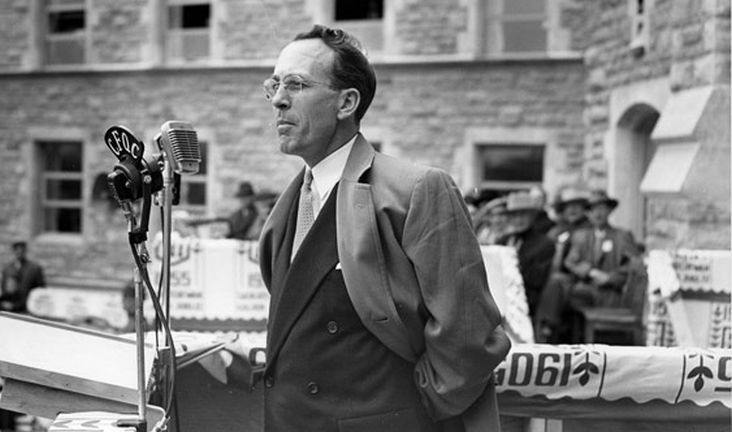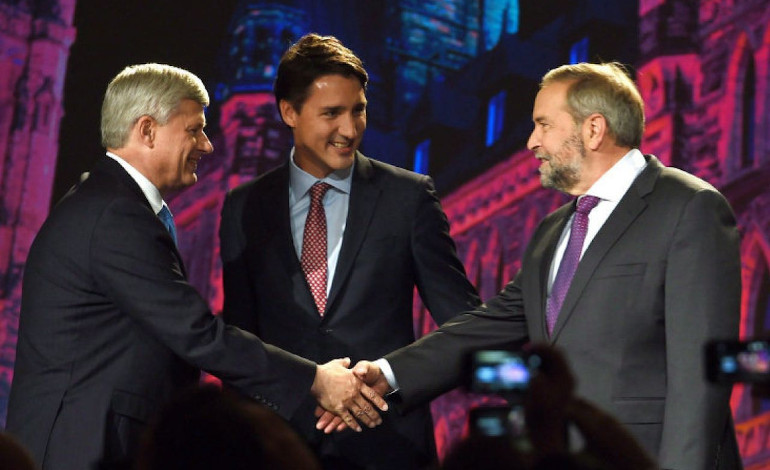Sixty years ago, North America’s first socialist government, in the heart of the Canadian prairies, Saskatchewan, enacted one of the demands outlined in its manifesto: a free, public health care system. This new program was enacted on July 1, 1962. However, this was not without a struggle, as on the first day of its enactment, the province’s doctors went out on strike, shutting down most health care services and doctor’s offices across the province for 23 days. The strike ended with an agreement signed by both doctors and the government on July 23, 1962.
Regina Manifesto
In the early 1930s, Saskatchewan, like much of the Prairies, was being ravaged by drought and depression. Life was tough. Dire poverty and high unemployment were rampant throughout the villages, towns and cities that dotted the landscape. It was in this context that the Co-operative Commonwealth Federation (CCF) formed, a mix of farmer unions, trade unions and socialists. In 1933 they met in Regina, Saskatchewan to create a bold political program calling for the eradication of capitalism and a socialist society. Among the demands in the 14-point Regina Manifesto was government-controlled economic planning, the socialization of finance and free medical coverage to Canadians with government-run health care.
Eleven years later, in 1944, the CCF was elected decisively, winning 47 of 53 seats in Saskatchewan’s legislature. Key to understanding how a socialist government was elected in a province populated by supposedly conservative farmers, is grasping the precarious economic position of the mainly grain farmers, who paid steep prices for imported high tariff goods while selling wheat on the competitive world market. In addition, the settlement of Saskatchewan in the early twentieth century, unlike some of the frontier settlement in the United States in the nineteenth century, was by working-class immigrants during a period of rising trade unionism, a growing world socialist movement and an active co-operative movement in several European countries. To survive the farmers had to cooperate. Two major leaders of the Saskatchewan Grain Growers Association (SGGA) had both been members of the British Labour Party and other leaders had been members of the Independent Labour Party of England and the Socialist Party in the US.
Socialist “alternative” promises public health care
Tommy Douglas, the CCF premier, soon “became a symbol of what the socialist alternative promised.” The CCF government created new crown corporations such as the Saskatchewan Power Corporation, established Canada’s first publicly owned automobile insurance service, the Saskatchewan Bill of Rights in 1947 (long before the Canadian Bill of Rights of 1960), as well as legislation that allowed the unionization of public servants.
A public health program was a key priority — developing Canada’s first hospital insurance plan in 1947 was one of the CCF’s first steps. The federal government followed with a national plan that helped fund diagnostic services and hospital-operating costs in conjunction with the provinces.
Swift Current: first universal health care program in North America
A key step along the road to universal public health provision was the establishment of a demonstration project in the Swift Current Health Region in 1946. Internationally prominent health experts were hired by the CCF government; they developed long-term and operational plans and helped implement these along with a number of local leaders. The Health Region’s Committee moved faster than the government’s intended gradual approach, deciding to provide a full range of services from the start organizing doctor services, hospitalization, children’s dental care, and a professional public health service that included nurses, immunization programs, and health inspectors. In just two years — from 1946 to 1948 —the number of doctors practising rose from nineteen to thirty-six. The establishment of provincial funding for hospitalization saved the region from near bankruptcy from the polio epidemic of 1947.
The Swift Current Health Region’s program was the first universal hospital and medical care program in North America and was begun two years before Britain’s newly-elected Labour government created the National Health Service (NHS). By all measures, the project was a success: the preventive and educational work of nurses and improved access to doctors led to a drop in the infant mortality rate to the lowest in Saskatchewan. Further, the Health Region demonstrated a functioning model for the design of the provincial Medicare system.
1960 election run on province-wide public health care
After establishing a clear and successful model that operated for more than a decade, the CCF was ready to launch a province-wide health care system. Douglas and the CCF campaigned vigorously on this, speaking to ordinary people in the many small towns and villages throughout the province. They held town hall meetings, discussions of neighbours at kitchen tables — they built powerful popular support. The election was called in June 1960 with the promise of Medicare being the key issue. The prospect of a medical insurance plan that would deliver public health services to every person in Saskatchewan was very popular and no other party campaigned openly against the plan. Three other major political parties — the Conservatives, Liberals and Social Credit — ran in the election but the main campaign against Medicare was from the College of Physicians and Surgeons.
The majority of the doctors in Saskatchewan were against Medicare and the college used scare tactics and misinformation to frighten the public. Among their claims were that Medicare would prevent patients from choosing their own doctors, that the government would be able to pass on medical secrets of patients and doctors would leave the province. By and large, these claims were rejected when the CCF was returned to office with a slight increase in seats. In total they won 37 of 54 seats, almost 41 percent of the popular vote.
Following the election, the government established a commission to recommend a plan. The Commission reported in September 1961. However, the Saskatchewan College of Physicians and Surgeons said they could not work with a “compulsory, government-controlled scheme.” The doctors fiercely objected to collecting their fees through the government plan. Instead, they proposed private insurance schemes, with poor people having their premiums paid by the government to these private companies and patients paying doctors directly. The government rejected the doctors’ proposals stating that this would not be acceptable to the people of Saskatchewan.
The CCF introduced the Saskatchewan Medical Care Insurance Act in October 1961. The Act was passed and given royal assent in November 1961. Although Douglas had been key in developing and promoting Medicare, he stepped down as premier just days before the bill became law to become leader of the newly-formed federal New Democratic Party, from the previous CCF, leaving incoming premier, Woodrow Stanley Lloyd, to carry on the fight.
Doctors fight plan
The fight was far from over. Those opposed included doctors, provincial, federal and even US medical associations as well as private insurers and media. These combined forces, representing conservative elements content with the status quo, showed great determination to fight the plan.
In early May 1962, two-thirds of Saskatchewan’s 900 doctors attended “a passionately charged meeting in Regina” and almost all doctors’ offices closed for two days. There, they resolved not to practise should the Act come into force. One spokesperson for the medical profession declared to loud applause that “never since the days of Charles II has there been such legislation reversing the civil rights and liberties of citizens.” Premier Lloyd, speaking to the angry assembly, said, “Medical care is not an optional commodity — it is a necessity. When medical services are needed they should not, in the interests of each of us, be denied to any of us. When a commodity or service is essential our society has long since accepted that consumers have a legitimate right to a voice in making the essential governing decisions in such matters. That voice has been, for medical care, embodied in the Saskatchewan Medical Care Insurance Act, an Act passed by a properly elected legislature of the province of Saskatchewan. …” He invited the doctors to “join in a bold attempt to consolidate past gains [in medicine] and to move toward new horizons in the field of medical care.” The audience responded with hisses, jeers, and boos.
An organized campaign against the government and its Medicare Plan was planned and backed by the government’s political opponents and media. Keep our Doctors (KOD) Committees formed as part of this effort, which recruited mothers who wished to show support for doctors. Rallies, petitions and advertisements all “raised the emotional climate to a white heat.” The campaign was backed by the Regina Leader-Post with warnings that most doctors would leave the province if “socialized medicine” were introduced.
On these so-called grassroots committees sat the owners of the largest drugstores in Saskatoon, two representatives of the Board of Trade, the owners of a lumber company, a hardware store, a cartage company, and a construction company, and the owner of one of the largest radio TV stations in Saskatchewan.
At one KOD rally, a caricature was featured of a supposed Saskatchewan-government-imported doctor, with a large Semitic nose, a Chinese pigtail, and middle east style of clothing, and bearing a large sign reading “Sask. Gov’t Medicare Import.”
Doctors strike and community response
On July 1, 1962, the Act came into force. The doctors kept to their word with 90 percent of doctors closing their offices. With the prospect of the strike looming, almost overnight, local citizen groups and some doctors organized community health clinics, just as they had organized other co-operatives in times of crisis.
In contrast to the fake grassroots of KOD, most in Saskatchewan supported the introduction of public health. Too many had faced years of going hungry to pay the doctor or not being able to afford to take their child to see the doctor.
In addition, not all doctors were opposed to public health care. Many doctors were not well paid, some barely subsisting, paid in chickens or eggs for their services. Two doctors in Saskatoon, Margaret Manhood and Joan Whitney-Moore, decided to set up a community clinic. This was to be among the first of many of such clinics around the province. They found a threadbare room in an office building and started seeing patients on July 3. Other doctors joined them, including Dr. Samuel Wolfe, an internationally known physician and researcher, and a professor of medicine at the University of Saskatchewan. He resigned his academic position to work at the clinic and later become its first medical director. Similar community health associations were organized in twenty-five centres across the province. These clinics, some of which operate today, offer a comprehensive range of health services in settings where medical professionals work in formal cooperation with citizen boards.
The government responded to the “doctors’ strike” by bringing in doctors from Britain, the United States and other provinces to staff these community clinics. The presence of these clinics diminished the impact of the strike. In addition, the strikers “seriously underestimated the extent to which there was pro-Medicare sentiment in Saskatchewan.”
However, there were vocal and vitriolic opponents, including a Catholic priest, Father Athol Murray of Wilcox, who spoke to a rally organized by a Saskatoon KOD Committee on the fifth day of the strike in front of 500 supporters at a Saskatoon high school. His speech was also carried over a network of radio stations. His words were described as a “foam-flecked delusional rant” directed at “bloody Commies.” He said, “There are three Reds here. I can’t see them. I can smell them.”
On July 11, a rally in support of the doctors was held in front of the Saskatchewan legislature in Regina. However, it attracted just 4,000 people, one tenth the number organizers hoped for.
Under pressure from these events, some of the striking doctors returned to work by mid-July with doctors increasing services at emergency centres and hospitals. By July 23, the momentum of the strike had diminished. The government hired a mediator, Lord Taylor, a British physician who had helped implement the National Health Service in the United Kingdom. The result was the “Saskatoon Agreement,” signed on July 23, 1962, thus ending the strike. Under the terms of the agreement, doctors were to be paid on a fee-for-service basis, a compromise. Many of the community health clinics were disappointed with this arrangement. They wanted doctors to be paid a salary. The agreement also had provisions for doctors to opt out of Medicare and increased the number of physicians on the Medical Care Insurance Commission.
While doctors returned to work, hostilities remained. Patients resented their doctors for abandoning them and doctors resented government interference. There were strained relationships between doctors who opposed Medicare and those who supported it, particularly those who chose to work in the community health clinics. A number of doctors who were new to the province were denied hospital privileges for months. However, just three years after Medicare was adopted, a survey of doctors found that most favoured its continuation.
Lessons and Aftermath
Although these events took place 60 years ago, there are lessons we can glean from this struggle today. The first is that the working class struggles for each and every reform. Reforms have to be campaigned for. The CCF did not base its public health policies on the views of newspaper editors or a compromise with big business. They knew the people of Saskatchewan (and Canada) needed access to health care and it could only be provided by a public service. The market will not provide health for all. They went out to campaign hard to win support for their principles and polices. They won overwhelmingly support that resisted Saskatchewan’s elite, editors, big business and many doctors. If only the NDP would act like that today!
The determination of a government, guided by socialist principles, along with the determination of ordinary people to win important gains for themselves and their families is a force that even the ruling class and elites cannot overcome. This story has been repeated with different players, on different themes in different places. Socialist Alternative has defeated the richest man on earth on the issue of the Amazon tax. The Bolsheviks came to power winning peace, bread and land for the people of Russia.
Secondly, the ruling class always tries to push back the gains of the working class, so workers must be vigilant. There are doctors, like Dr. Brian Day in Vancouver, who wants to make big profits from health. His goal is to double-dip — or charge both the province and patients for health services. He launched a constitutional challenge in 2009 to sections of the Medicare Protection Act that prevent doctors in BC from billing patients above the rate paid through the Medical Services Plan (MSP) and that prohibit the sale of private insurance that covers treatment provided under MSP.
On July 15, the BC Court of Appeal decided in favour of the current public health legislation and against Dr. Day, and his aim for two-tier health provisions. However, this battle is ongoing and is not just a legal battle, although this recent ruling is an important victory for the principles of publicly provided health care. Health care today needs to be defended against a death by a thousand cuts, from inadequate services, insufficient staffing, and long waitlists. Unions and the working class must stand up for health care workers, who have worked tirelessly during the past two and a half years of the COVID pandemic.
While there are pushes against universal health care, the reality is that publicly provided health care was so popular, that the Saskatchewan model was adopted right across Canada by 1972, with this process started by a Conservative Prime Minister, John Diefenbaker. Sixty years later, the community clinics, born out of a crisis, provide health services to people in Saskatchewan today.



